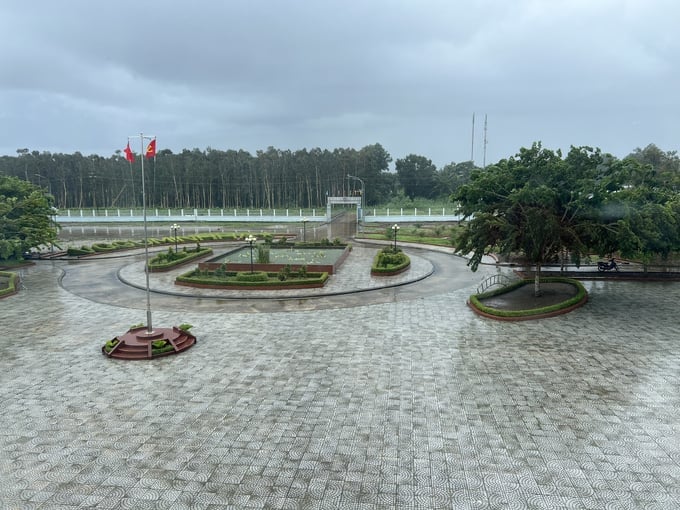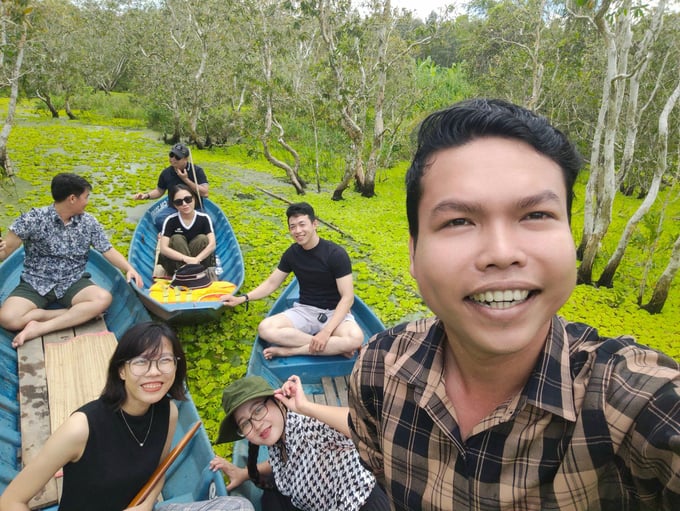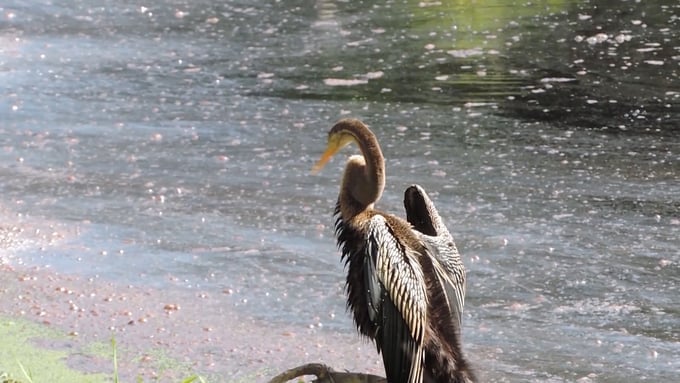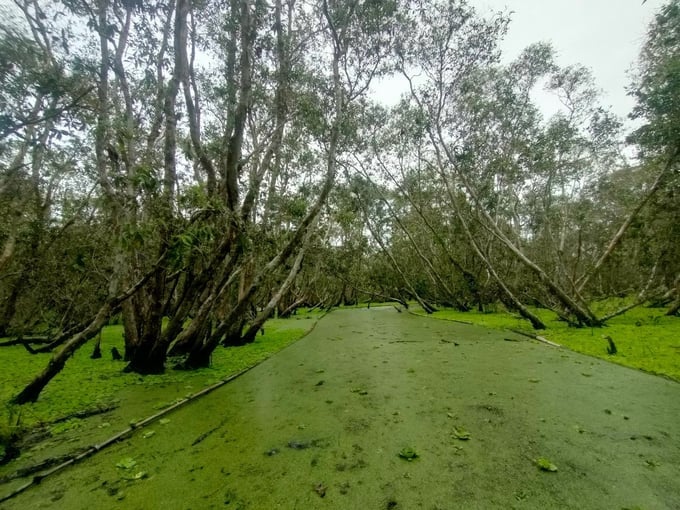June 21, 2025 | 02:06 GMT +7
June 21, 2025 | 02:06 GMT +7
Hotline: 0913.378.918
June 21, 2025 | 02:06 GMT +7
Hotline: 0913.378.918

The U Minh Ha National Park is recognized by UNESCO as one of three main areas in the Ca Mau Cape World Biosphere Reserve, with a total area of 8,830 hectares. Photo: Trong Linh.
Ca Mau is the southernmost coastal province of the country, shaped like a peninsula bordering both the West and East Seas with a coastline of 254 km. Ca Mau’s climate is temperate, located in the sub-equatorial, tropical monsoon region, with two distinct rainy and sunny seasons and unaffected by floods and rarely storms. The natural area of the whole province is more than 5,220 km2.
Ca Mau province is rich in forest and marine resources, with a flooded forest ecosystem covering an area of more than 100,000 hectares divided into two regions: Brackish and alum-flooded forests characterized by melaleuca trees, mainly located deep inland in the region. U Minh Ha and mangrove forests characterized by mangrove trees and fish sauce trees are mainly in Ca Mau Cape and coastal areas. In the forest, there are also many species of animals and plants with ample reserves, which are specialties of flooded forests. Ca Mau forest is famous worldwide and is second only to the mangrove forest at the mouth of the Amazon River (Brazil).
Mr. Tran Cong Hoang, Director of U Minh Ha National Park shared: “The U Minh Ha National Park was established in 2006 when Vo Doi Nature Reserve was merged with a part of the Melaleuca forest. It has been recognized by UNESCO as one of the three core areas of the Ca Mau Cape World Biosphere Reserve, with a total area of nearly 8,830 hectares in our nation’s 32 national parks.”

It is necessary to see the full tourism potential in the U Minh Ha National Park. Photo: Trong Linh.
Of which, the Vo Doi area of nearly 2,900 hectares is the only remaining primeval forest in Ca Mau province, with about 176 species of natural plants. The Melaleuca forest is truly a living ecological museum of plant species belonging to the flooded forest ecosystem of the Mekong Delta region in particular and the whole country in general.
Besides, within the forests, there are more than 184 km of canals with a total water surface area of more than 1,000,000m2 (not including the area of seasonally flooded grass beds). This is truly a paradise for freshwater fish species. Accordingly, U Minh Ha National Park is divided into three functional subdivisions to perform the tasks of management, protection, biodiversity conservation, and development investment. The Park is expected to plan an eco-tourism area with nearly 1,320 hectares (including an administrative service area and ecological recovery area).

U Minh Ha National Park has 91 bird species, including many rare species. Photo: Trong Linh.
With the above potential and strengths, U Minh Ha National Park is one of the attractive ecotourism destinations for tourists.
Especially during the fish farming season, visitors can easily encounter a number of fish species with scientific and economic value such as snakehead fish, butterfly gourami, yellow catfish, perch, sandalwood, etc. This place is not only rich in species composition but also has a very large concentration of individuals.
Besides, visitors can observe groups of monkeys climbing trees to pick fruit and many species of birds flying in and out in bustling flocks. On the other hand, U Minh Ha also has traditional craft villages and specialties originating from the Melaleuca forest ecosystem. So, if traditional craft villages of the Melaleuca forest are combined, they will contribute to eco-tourism.
Mr. Hoang said that, besides the potential and advantages bestowed by nature, in recent years, tourism activities in U Minh Ha National Park have faced many limitations. Specifically, tourism activities are monotonous and small-scale, the system is still limited, the quality of eco-tourism services is not guaranteed, managers and instructors still need to be improved, etc.

U Minh Ha National Park is one of the attractive ecotourism destinations for tourists. Photo: Trong Linh.
The above difficulties and limitations make tourism activities in U Minh Ha National Park not commensurate with its potential and advantages. Therefore, the U Minh Ha National Park managers and the Ca Mau tourism industry have established the “Ecotourism Development in U Minh Ha National Park until 2025” Project. This project will create favorable conditions to develop tourism services here, contributing to enriching local products.
Translated by Quynh Chi
![Turning wind and rain into action: [9] Digitizing hydrometeorological data in response to climate change](https://t.ex-cdn.com/nongnghiepmoitruong.vn/608w/files/news/2025/06/17/z6704423696987_15fd32ffc26d590d204d520c9dac6786-nongnghiep-165943.jpg)
(VAN) Farmers have begun accessing hydrometeorological applications to adjust their cropping schedules, aiming to ensure productivity and adapt to climate change.
![Turning wind and rain into action: [8] Real-time salinity detection and early warning technology](https://t.ex-cdn.com/nongnghiepmoitruong.vn/608w/files/news/2025/06/17/z6704423696987_15fd32ffc26d590d204d520c9dac6786-nongnghiep-151127.jpg)
(VAN) Thanks to the integration of modern hydrological-hydraulic models, remote sensing technologies, and artificial intelligence, the accuracy of hydrological forecasting has significantly improved.
![Turning wind and rain into action: [7] Early disaster warnings help marine farmers minimize losses](https://t.ex-cdn.com/nongnghiepmoitruong.vn/608w/files/news/2025/06/17/z6704423696987_15fd32ffc26d590d204d520c9dac6786-nongnghiep-142942.jpg)
(VAN) In recent years, thanks to early disaster warnings and forecasting, marine farmers in Khanh Hoa province have been able to reduce risks and losses, thereby improving production efficiency.
![Turning wind and rain into action: [6] ‘Four on-the-spot’ disaster management software](https://t.ex-cdn.com/nongnghiepmoitruong.vn/608w/files/news/2025/06/17/e5a48259d6a262fc3bb3-nongnghiep-183800.jpg)
(VAN) By simply activating the scenario on the disaster management software, the relevant authorities immediately know how many households need to be evacuated, where to evacuate them to, and by what means of transportation…
![Turning wind and rain into action: [5] Hue applies modern technology in disaster forecasting](https://t.ex-cdn.com/nongnghiepmoitruong.vn/608w/files/news/2025/06/17/z6704423696987_15fd32ffc26d590d204d520c9dac6786-nongnghiep-093938.jpg)
(VAN) In Hue city, modern technology has recently been applied in meteorological and hydrological forecasting and warning, helping to reduce the damage caused by natural disasters.

(VAN) A cutting-edge farming technique being implemented on an experimental ranch in Arizona's Sonoran Desert has already saved a billion gallons of water over five years, according to Civil Eats.

(VAN) Poultry and pig production and the environment can be boosted through enhanced water technology, according to new research.